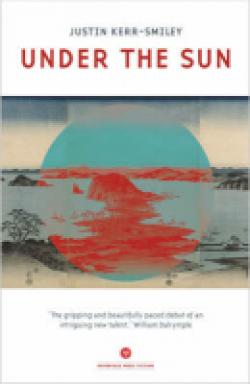Under The Sun

Reportage Press, 2007
243 Pages,
ISBN13: 9780955572937 (Hardback)
Review by Susan Meehan
In Under the Sun, Justin Kerr-Smiley’s debut novel, we are introduced to young Flight Lieutenant Edward Strickland. Strickland, whose study of Greats at Oxford is curtailed by the onset of the Second World War, develops, over the course of the book, from a young RAF Spitfire pilot, into a more worldly individual coming to terms with the loss of love, friends and comrades.
Deployed to the South Pacific in the closing stages of World War Two, Strickland, flying sorties over the Carolines, is shot down by a Japanese submarine countering his attacks. Plummeting to the sea and to certain death, he is noticed and rescued, however, by a group of Japanese soldiers stationed on a remote island, anxious at all costs to remain concealed, and unsure as to what to do with the captured enemy.
While Under the Sun makes for compelling and tense reading at times, once the theatre of war moves from Europe to the South Pacific, the cliches and episodes of florid language become too many to list and Strickland seems more like a character out of James Clavell’s Shogun than a believable war hero.
Like Clavell’s 17th Century Pilot-Major, John Blackthorne, whose trading ship runs aground off the Japanese coast, Strickland narrowly escapes death by his captors, who then proceed to protect and look after him despite endangering themselves in doing so. In both cases the non-Japanese becomes an accepted and integral part of the group in which he has landed.
The world inhabited by Strickland and the Japanese island-garrison is a bit too idyllic at times, somewhat reminiscent of Asterix the Gaul’s enclave, “…one small village … still holds out against the invaders …..” It is fanciful to think that the island harbours no dissenters who may want to harm Strickland.
Then there is Commander Hayama, a textbook character personifying a range of cliche which, one would hope, are no longer prevalent – though fierce he is also sensitive with exquisite fine tastes. Brutal to Strickland initially, Hayama not only gives an outward appearance of sensitivity with his feminine face and smooth skin, this entomologist manque spends his free time either collecting or cataloguing his butterflies; changing into his kimono to play the violin, writing haiku, burning incense or praying to his ancestors for illumination.
The language is cringeworthy at times; the friendship between Hayama and Strickland is rendered thus, “… their friendship had survived the ordeal and their souls were now forged together like the steel of a samurai’s sword. Whatever the gods decreed, they would face it together.”
Even more overworked is the following passage, “…the sun rose like a nymph from the deep, naked and tender as a newborn, flames flickering and falling from her shoulders in a burning watery garment, the sea coiling and writhing like a serpent beneath her feet.”
And there seems to be a certain lack of imagination in the depiction of Inoue; Hayama’s orderly, the good Japanese, happens to be a Christian from Nagasaki, almost implying that a Buddhist would be incapable of the same kindness. Perhaps in order to make up for this, we later read that, “Karma was not only a tenet of Buddhism but also of Christianity. St Paul had said precisely this in his letter to the Galatians when he wrote, ‘whatever man sows, he shall reap.’ The two faiths had many aspects that complimented each other. They were like two halves of the same fruit and in the middle were the pips, the seeds of faith.”
Contrived situations including a shark attack and seppuku continue apace and the typos (Hamaya instead of Hayama, repetition of words: to to, written written etc) don’t help either.
Still, an interesting read and a percentage of the proceeds go to a good cause!

